#henotheism
Text
Varieties of Theism
Agnostic Theism
Whereas atheism and theism deal with belief, agnosticism deals with knowledge. The Greek roots of the term combine a (without) and gnosis (knowledge). Hence, agnosticism literally means “without knowledge.” In the context where it is normally used, the term means: without knowledge of the existence of gods. Since it is possible for a person to believe in one or more gods without claiming to know for sure that any gods exist, it's possible to be an agnostic theist.
Monotheism
The term monotheism comes from the Greek monos, (one) and theos (god). Thus, monotheism is the belief in the existence of a single god. Monotheism is typically contrasted with polytheism (see below), which is a belief in many gods, and with atheism, which is an absence of any belief in any gods.
Polytheism
Polytheism is the belief in the existence of multiple gods. The prefix ''poly'' means many, so polytheists believe that there are multiple divine forces in existence. The Greek and Roman pantheons are excellent examples of these, as they consist of many gods that govern different aspects of nature and essences of humanity. Some argue that Christianity is a polytheistic religion because of the worship of the Trinity. However, the Father, Son, and Holy Spirit are all aspects of a single God, making it a monotheistic religion.
Deism
Deism is actually a form of monotheism, but it remains distinct enough in character and development to justify discussing separately. In addition to adopting the beliefs of general monotheism, deists also adopt the belief that the single existing god is personal in nature and transcendent from the created universe. However, they reject the belief, common among monotheists in the West, that this god is immanent—presently active in the created universe.
Henotheism and Monolatry
Henotheism is based upon the Greek roots heis or henos, (one), and theos (god). But the term is not a synonym for monotheism, despite the fact that it has the same etymological meaning.
Another word expressing the same idea is monolatry, which is based on the Greek roots monos (one), and latreia (service or religious worship). The term appears to have been first used by Julius Wellhausen to described a type of polytheism in which just a single god is worshiped but where other gods are accepted as existing elsewhere. Many tribal religions fall into this category.
Pantheism
The word pantheism is built from the Greek roots pan (all) and theos (god); thus, pantheism is either a belief that the universe is God and worthy of worship, or that God is the sum total of all there is and that the combined substances, forces, and natural laws that we see around us are therefore manifestations of God. The early Egyptian and Hindu religions are regarded as pantheistic, and Taoism is also sometimes considered a pantheistic belief system.
Panentheism
The word panentheism is Greek for “all-in-God,” pan-en-theos. A panentheistic belief system posits the existence of a god that interpenetrates every part of nature but which is nevertheless fully distinct from nature. This god is, therefore, part of nature, but at the same time still retains an independent identity.
Impersonal Idealism
In the philosophy of Impersonal Idealism, universal ideals are identified as god. There are elements of impersonal idealism, for example, in the Christian belief that "God is love," or the humanist view that "God is knowledge."
Autotheism
The term ''autotheism'' is composed of two parts: the prefix, ''auto,'' and the root/suffix combination, ''theism.'' ''Auto'' means ''self, one's own, by oneself.'' So, autotheism is the belief that one is a god themself. It has also been described as someone who mistakes one's inner voices as God's voice within them.
Kathenotheism
The belief that there are many gods, but only one deity at a time should be worshipped, each being supreme in turn.
Ditheism (or Duotheism)
The belief in two equally powerful gods, often, but not always, with complementary properties and in constant opposition, such as God and Goddess in Wicca, or Good and Evil in Zoroastrianism and Manichaeism. The early mystical religion Gnosticism is another example of a ditheistic belief of sorts, due to their claim that the thing worshipped as God in this world is actually an evil impostor, but that a true benevolent deity worthy of being called "God" exists beyond this world.
Misotheism
The belief that gods exist, but that they are actually evil. The English word was coined by Thomas de Quincey in 1846. Strictly speaking, the term connotes an attitude of hatred towards the god or gods, rather than making a statement about their nature.
Dystheism
The belief that gods exist, but that they are not wholly good, or possibly even evil (as opposed to eutheism, the belief that God exists and is wholly good). Trickster gods found in polytheistic belief systems often have a dystheistic nature, and there are various examples of arguable dystheism in the Bible.
Animism
Animism is the idea that all things—animate and inanimate—possess a spirit or an essence. First coined in 1871, animism is a key feature in many ancient religions, especially of indigenous tribal cultures. Animism is a foundational element in the development of ancient human spirituality, and it can be identified in different forms throughout major modern world religions.
Totemism
Totemism is a system of belief in which man is believed to have kinship with a totem or a mystical relationship is said to exist between a group or an individual and a totem. A totem is an object, such as an animal or plant that serves as the emblem or symbol of a kinship group or a person. The term totemism has been used to characterize a cluster of traits in the religion and in the social organization of many primitive peoples.
#theism#paganism#greek polytheism#varieties of theism#animism#totemism#dystheism#misotheism#ditheism#duotheism#kathenotheism#autotheism#panentheism#pantheism#henotheism#deism#monotheism
192 notes
·
View notes
Video
Dive into the world of Henotheism with our latest video exploration. Henotheism, a unique belief system, focuses on devotion to a single deity while acknowledging others. Join us as we unravel the origins and intricacies of Henotheism, offering a clear understanding of its place in the tapestry of religious ideologies. Subscribe for straightforward insights into Henotheism, and stay tuned for more content simplifying the complexities of faith. At Monotheist, we're dedicated to making the exploration of religious perspectives clear and engaging. #Henotheism #ReligiousBeliefs #DeityWorship #MonotheisticViews #TheologyExplained #FaithJourney #ReligiousDiversity #BeliefSystems #SpiritualInsights #UnderstandingHenotheism #OriginOfBeliefs #ExploringFaith #ReligiousIdeologies #MonotheismVsPolytheism #CulturalBeliefs #GodsAndDeities #PhilosophyOfFaith #SingularDevotion #HenotheismExploration #MonotheistChannel
#Henotheism#Monotheist#Religious Beliefs#Origin of Henotheism#Monotheistic Views#Theology Exploration#Faith Journey#Understanding Belief Systems#Exclusive Deity Devotion#Religious Diversity#Cultural Beliefs#Monotheism vs Polytheism#Faith Exploration#Origin of Beliefs#Divine Worship#What is Henotheism? | Henotheism Explained | Origin of Henotheism#monotheism#bible#christianity#What is Henotheism#Henotheism Explained#henotheism definition#polytheism
2 notes
·
View notes
Text
Recently Ocean Keltoi wrote a thread about what pagans can learn from the Bible. He basically claimed that the Bible is an incredible resource for pagans with regards to magic, offerings, sacrifice, and both historical and mythological storytelling, adding that hatred of Christianity stops pagans from appreciating that and thus "blocks one's ability to grow".
I'm going to be honest, that thread was kind of an L from Ocean. But I will say that the Bible could be a resource, depending exactly on what you're looking for. Because if you're looking for "pagan practice" you're probably not going to find it. Or, if you do, it's largely going to be from the perspective of people who despised the various polytheistic cults and traditions that surrounded them at the time. I suppose if you're looking for something to base Christian magic or the like on, I think it'd be more useful to look into the systems of (again, Christian) folk magic that actually used the Bible in invocations or spell-casting.
But here's what I would prefer to gleam from the Bible, if anything, as relevant strictly to my own approach:
Henotheism in a polytheistic cosmos: Technically, the narrative of the Bible does assume a cosmos in which multiple gods besides Yahweh exist, just that the narrative of the Bible centers around the worship of Yahweh and generally insists upon the sole worship of Yahweh. Indeed, there seems to be a whole council of divine beings who Yahweh presides over, and who gradually lose their stature as Yahweh condemns them. Other gods roam the land, receive worship, and even contend against Yahweh in struggles for power and/or territory. Adam and Eve eating the fruit of the tree of knowledge is explicitly stated as setting them on the path to joining the gods. This creates some ground for "Pagan" treatments of the Biblical landscape, not entirely unsuited to navigating our contemporary religious superstructure. It is also this exact henotheistic landscape that can, with little difficulty, reflect backwards towards the "pagan" cosmoses, often sites of divine rebellion.
Demonology: The Bible is full of demons, alongside its own distinct notion of the demonic. Granted the Apocrypha tend to have a lot more demonology going for them, but the Bible has a wide catalogue of demons that infest the popular imaginary to this day. Christian demonologists have of course frequently derived some of their demons from pagan gods that appeared in the Bible (for example Berith, Adrammelech, Astaroth, Beelzebub, to name just a few) and elsewhere. As Andrew Mark Henry (the Religion For Breakfast guy) noted recently, the demonic has its own way of conveying a sort of outer and/or inner shadow relative to the culture. To pronounce heresy in some ways vivifies that shadow, giving it form and content. The gods, even as demons, speak, even in the voices of demons, their cult, their divine content, and in this form do so in a subversive role.
For that particular point I would suggest a new video on the demonology of The Legend of Zelda. Yes, you heard that right.
youtube
Cosmic pessimism: This part may sound quite strange, but it's very easy to get a throughline of. Granted it's mostly relevant to Christianity, which as far as I can see really doesn't have the benefit of getting to argue with God that Jewish rabbinical tradition actually seems to have. But picture, for classical monotheism at least in "Western" terms, the throughline of a seemingly all-powerful singular deity, who is to be treated as the sole sovereign of the universe. That power, that intelligence, governs the whole of life and its course, and so is invariably responsible for its death. It is also possible to see a constant struggle of humanity with even the divine itself - a theme which can be found more often than you'd think in the Old Testament, but which is poorly appreciated, if at all, by Christianity at large. Whether it's Adam and Eve defying God and being exiled, arguably the story of the Tower of Babel whereby the tower itself is a struggle to connect humanity to the divine which is thwarted by God, Job demanding an explanation from God for all his turmoils before ultimately accepting God's word, or the story of Jacob wrestling with the angel or apparently God itself and being declared victorious by God itself and taking the name Israel as a result, there's actually quite a lot to work with that can furnish an admittedly rugged and darksome perspective on the universe. Not to mention exegesis around the "fall".
But all this is just what I can think of, and if anything a lot of it still assumes a counter-narrative assemblage. What Ocean has in mind to my mind seems altogether different, and the nature of that difference is in some ways the problem. Ocean thinks that the problem of the Biblical narrative is mostly that it was simply used to cultivate a supremacy narrative for Christianity, and I think that's a rather simplistic way to look at it, particularly when, if we're talking about supremacy, the proclamations of the sovereignty of a single god are right there, in the text. Even if it's about use, strictly, if you want to use it for that it's certainly not hard. But then the rest of Ocean's thread is essentially him talking about how witches and magicians invoked verses of the Psalms for example in their magic. But that's not actually in itself "Biblical insight on magic". That's Christians practicing their own variety of folk magic, in the name of the Christian God, probably centuries after the Bible was written. It's just saying that Christians have done magic with the Bible and that it's a part of history so you have to consider it as a pagan, never mind that it might not actually be relevant to your practice as a pagan, because reasons. I would have brought up the Greek Magical Papyri or The Eighth Book of Moses as better examples just because they actually seemed to involve invoking pagan gods like Horus or Helios alongside Jesus Chrestos, Michael, Gabriel, Raphael, and Iao Sabaoth in some spells while ostensibly still operating around very pagan ideas about religion and magic but hey, that's just me.
4 notes
·
View notes
Text
DEFINING HINDUISM

Though I've been an atheist and still am one. Being born into a Hindu family has always made me proud. And the reason for this is that, after decades of research on spiritualism, particularly how it began and evolved from India through the Hindus, I've concluded. Hinduism is more than just a religion. So, if you're interested in understanding more about Hinduism and its nuances, let me tell you about my understanding of Hinduism.
In my view, a Hindu is an atheist, polytheist, monotheist, and henotheist. He is henotheistic because he believes in only one God yet acknowledges the presence of other deities and subsidiary gods. For example, while Shiva is the most superior Hindu god, Hindus also worship many other lesser gods to whom there is no end or limit. This means that a Hindu can pray to anything around - a tree, a cow, a mountain, a stone or a river.
This distinguishes Hinduism from all other religions. It is a philosophy, even though now muddled up with supernatural beliefs and traditions. Hinduism cannot be called a religion. It's a way of life for them. It arose from various interconnected thoughts such as demographics, cultural practices, and ancient philosophical scriptures and teachings.
It evolved over thousands of years and is the oldest known religion globally. All beliefs and myths add up from one generation to another—philosophers, pundits, commentators, interpreters, gurus, etc.
Each of them comes up with their names, concepts, and supernatural beliefs. Many religions, including a subset of religions, have been influenced by Hinduism, including Sikhism, Jainism, Buddhism, etc. I'd go so far as to say it's the mother of all religions.
According to Yajurveda, "All living beings are equally divine." As a result, when all living creatures are equally divine, and the Hindu religion accepts everyone and allows other religions to coexist in its embrace, it must have been the mother of all ideologies.
Add to that the fact that there is no conversion in Hinduism from one religion to another. It also doesn't have a founder or any precepts. It consists solely of Mahavakyas or great sayings.
The Hindus in Hinduism
Let's take a closer look at the term "Hindu." The Persians coined the term "Hindu," which they used to describe the people who lived beyond the Shindus River. They couldn't distinguish between the sounds "SA" and "Ha" when pronouncing the word Sindhu, So Sindhu turned Hindu.
As you must have noticed, there is no -ism in it. The term "Hinduism," which relates to the Hindu people's religion, was coined later. They could not understand its true nature as an outsider looking in and just called it a religion. Hinduism is a way of life, not a religion, to realise one's full potential.
God in Hinduism is that of pure consciousness. A final destination for Aatma (the soul) to realise absolute awareness. In Hinduism, unlike any other faith, the Creator and creation are the same. There is no distinction. Since you have that divinity within you, you are that potential divine. This means God is the highest state of pure consciousness to liberate the human body and mind we call Moksha.
The above implies that the divine exists because of you, the earth exists because of you, the universe exists because of you, and everything exists because of your aware-conscious energy contained in the soul. You, as the potential divine, came first, and god followed.
The Knowledge of Self
In Hinduism, this is what is divine. So, with this spiritual knowledge, the most crucial thing in life is not to follow traditions but self-knowledge for that self-awakening to realise self-awareness of who we are beyond body and mind. This self-awareness teaches you that God, Guru, and the Self are one. Advaita Vedanta is the name given to that absolute non-dual state of aware energy; the supreme ability of energy - Brahman referred to as Parabrahman or Paramatma; par meaning beyond.
All of this sprang from four Upanishad mahavakyas. When they declared, "Prajnanam Brahma," - Insight is the creator of everything in the cosmos (Brahman). The second, "Ayam Aatman Brahma", is Brahman - the Soul, which contains the spirit. Third, "Tat Tvam Asi" - That art Thou, and the fourth is "Aham Bhramasmi," which means "I am that Brahman, the one in many and the many in One - total energy.
The Vedas are the foundational texts of Hinduism; it concludes with Advaita Vedanta, which is the essence and philosophical knowledge of the Upanishads.
Let us now consider how supreme and sublime the entire concept of Hinduism's scriptures is. Perhaps this is why the Upanishads offered us four life goals to follow.
These four goals in life are Dharma, Artha, Kama, and Moksha.
· One of the numerous meanings of Dharma is righteousness, which means the divine order of the human person.
· The second purpose is Artha, which aims for economic growth.
· The Kama is the third. It is to fulfil your essential desires and, finally, to be satisfied.
· The ultimate objective for Hindus is to achieve Moksha or liberation.
Sanatan Dharma is the actual name of Hinduism. Sanatana is Sanskrit for "eternal law." And Dharma is the order of righteousness, formed by combining two words into one.
As to how?
Dharma refers to how you should live, whereas karma refers to how you are already living, with the Sanatan – eternal laws filling in the gaps.
The universal law of eternity, the universal rule of righteousness, the universal law of non-duality, where there is no duality or relativity; because the truth, God, and everything else is related towards duality in our mind to its opposite?
All you need to do now is awaken that God, the Atma, in the centre. So that the soul can check and guide the mind to make it alert, attentive and aware to progress from lower to higher consciousness towards non-duality in absoluteness for that ultimate fulfilment.
Therefore, Hinduism is different from all other religions. It teaches you that salvation is found more in your religiousness, devoutness in religiosity. To awaken and liberate from the clutches of the material mind experiencing to realise that the God Guru and the actual Self are lying dormant within.
Namaste, and thank you once again for giving me your precious time.
#hinduism#sanatandharma#vedas#upanishads#atman#brahman#advaitavedanta#selfknowledge#moksha#dharmic#divineconsciousness#karma#polytheism#hinduphilosophy#henotheism#spiritualism#vedicwisdom#ancientreligion#wayoflife#motherofallreligions.#Spotify
2 notes
·
View notes
Text
Henotheism
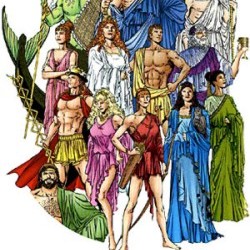
Henotheism (Greek "one god") is a term coined by Max Müller, to mean devotion to a single primary god while accepting the existence or possible existence of other deities. Müller stated that henotheism means "monotheism in principle and polytheism in fact". He made the term a center of his criticism of Western theological and religious exceptionalism (relative to Eastern religions), focusing on a cultural dogma which held "monotheism" to be both fundamentally well-defined and inherently superior to differing conceptions of God.
Variations on the term have been inclusive monotheism and monarchical polytheism, designed to differentiate differing forms of the phenomenon. Related terms are monolatrism and kathenotheism, which are typically understood as sub-types of henotheism. The latter term is an extension of "henotheism", from (kath' hena theon) —"one god at a time". Henotheism is similar but less exclusive than monolatry because a monolator worships only one god, while the henotheist may worship any within the pantheon, depending on circumstances. In some belief systems, the choice of the supreme deity within a henotheistic framework may be determined by cultural, geographical, historical or political reasons.
0 notes
Text
Other Gods Mentioned in the Old Testament
BaalThe Canaanite Fertility God
“You shall have no other gods before me” (Exodus 20:3).
The second commandment declares that in Israel no other god should be worshiped in addition to Yahweh. While the intent of the commandment may have included the idea of monotheism, the words of the commandment do not deny the existence of other gods. The truth of monotheism, that there was no other God besides…

View On WordPress
0 notes
Text
the fact that the words ‘sun’ and ‘moon’ appear nowhere in the creation account of genesis (using the awkward euphemism of the greater light and lesser light instead) makes me think it is probably a redacted version of an earlier work
#no news to anyone but i jus realised this#makes sense of course since it could seem as the names of the planets were the same as the names of the gods of those planets#so when God creates the sun to rule over the day it could have hinted towards poly/henotheism; which of course would be unacceptable
4 notes
·
View notes
Text
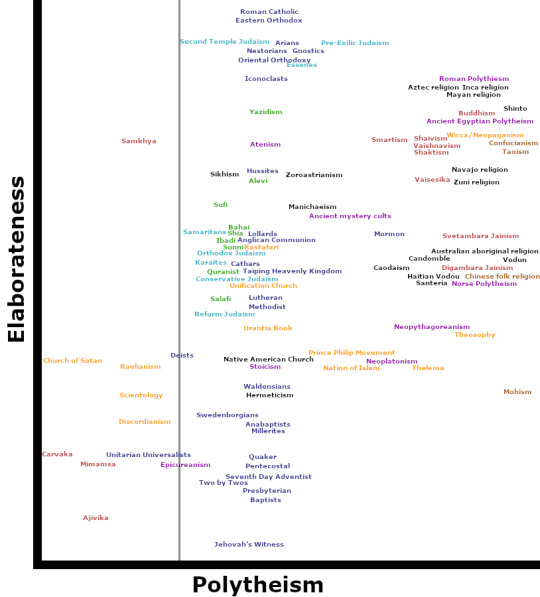
Revised version of "polytheism vs elaborateness" religion chart. I started with a list of around 150 religions, sects, denominations, philosophies, and spiritual tendencies, whittled down to 100 based on what I could find information on and what meaningful differences would actually show up in a chart like this. Dark blue is Christianity and Christian-derived tendencies; light blue is Judaism and Jewish-derived tendencies; green is Islam and Islam-influenced tendencies; purple is ancient Mediterranean polytheism and related schools of thought; red is Dharmic/Hindu-influenced schools of thought; tan is Chinese religion and philosophy; orange is new religious movements; black is other, unaffiliated religions and movements.
Obviously, "what is a religion" is a complicated topic. Some of the things on this chart might strike you more as philosophical schools (Carvaka, Stoicism), epistemological approaches (Unitarian Universalism), or different ways of slicing the same tradition. The scholarly definition of "religion" is sort of fundamentally circular, and that's not something I'm interested in trying to untangle for this entirely non-scientific exercise.
Religions etc. are scored on two axis: polytheism vs elaborateness of practice. Polytheism is a rank from zero to 11, thus:
0. Strict atheist and materialist, denying the possibility of both gods and the supernatural, e.g., Carvaka.
1. Atheist. Denies the existence of significant supernatural agents worthy of worship, but may not deny all supernatural (or psychic, paranormal, etc.) beings and phenomena (e.g., Mimamsa).
2. Agnostic. This religion makes no dogmatic claims about the existence of supernatural beings worthy of worship, and it may not matter for this religion if such beings exist (e.g., Unitarian Universalists). It does not preclude--and may actually incorporate--other supernatural, psychic, or paranormal phenomena (e.g., Scientology).
3. Deist. This religion acknowledges at least one god or Supreme Being, but rejects this being's active intervention in the world after its creation (e.g., Christian Deism). Deism is marked with a gray line on the chart, in case you want to distinguish religions that specifically care about all this God business from ones that don't.
4. Tawhid monotheist. This religion acknowledges only a single transcendent god above all other natural or supernatural beings, who is usually the creator of the universe and the ground of being, and is without parts, division, or internal distinction (e.g., Islam).
5. Formal monotheism. This religion acknowledges a single god, usually transcendent above all other natural or supernatural beings, but who may have aspects, hypostases, or distinct parts (e.g., Trinitarian Christianity). Pantheism may be considered a special case of formal monotheism that identifies the universe and its many discrete phenomena with a single god or divine force.
6. Dualism. This religion acknowledges a single god worthy of worship, alongside a second inferior, often malevolent being that nevertheless wields great power in or over the world (e.g., Zoroastrianism or Gnosticism).
7. Monolatrist. This religion or practice acknowledges the existence of many gods or divine beings worthy of worship, but focuses on, or happens to be devoted to only one of them (e.g., ancient mystery cults; pre-exilic Judaism).
8. Oligotheist. This religion worships a small group of divine beings, who may function for devotional or rhetorical purposes as a single entity (e.g., Mormonism, Smartism).
9. Monogenic polytheism/Henotheism. This religion worships many gods, which it sees as proceeding from or owing their existence to, a single underlying or overarching force or supreme god (e.g., many forms of Hinduism).
10. Heterogenic polytheism. This religion worships many gods, who have diverse origins and/or natures. Though the number of gods is in practical terms probably unlimited, gods are discrete entities or personalities, i.e., they are "countably infinite" (e.g., many polytheistic traditions).
11. Animism. This religion worships many gods which may or may not be discrete entities, and which may or may not be innumerable even in principle, i.e., they are "uncountably infinite" (e.g., many animist traditions).
What counts as a god is naturally a bit of a judgement call, as is exactly where a religion falls on this scale.
Elaborateness of practice is based on assigning one point per feature from the following list of features:
Uses vs forbids accompanied music in worship
Saints or intermediary beings accept prayers/devotion
Liturgical calendar with specific rituals or festivals
Practices monasticism
Venerates relics or holy objects
Clerics have special, elaborate clothing
Clerics have special qualificiations, e.g., must be celibate or must go through elaborate initiation/training
Elaborate sacred art or architecture used in places of worship
Sites of pilgrimage, or other form of cult centralization
Sophisticated religious hierarchy beyond the congregational level
Mandatory periods of fasting and/or complex dietary rules
Specific clothing requirements for laypeople
Specific body modifications either required or forbidden for laypeople
Liturgical language
Complex ritual purity rules
Performs sacrifice
Performs human sacrifice (or cannibalism)
Uses entheogens
Uses meditation or engages in mystical practice
Additionally, a point is taken away for austerity for each of the following features:
Forbids secular music outside worship
Claims sola scriptura tradition
Practices pacifism or ahimsa
Requires vegetarianism of all adherents
These scores are probably pretty inexact, since I am not a scholar of world religion.
This chart is not scientific, it's just a goof based on that @apricops post.
Other fun dimensions along which to chart religions might be:
Orthodoxy vs orthopraxy
Authoritarianism/control of members. This would add some much needed distinctions to Christian sects in particular, and to the new religious movements.
Elaborateness of cosmological claims. Some religions (looking at you, Buddhism) really go hog-wild here.
Social egalitarianism. Even within the same framework/tradition/philosophy, some practices differ radically on how egalitarian they are.
990 notes
·
View notes
Photo
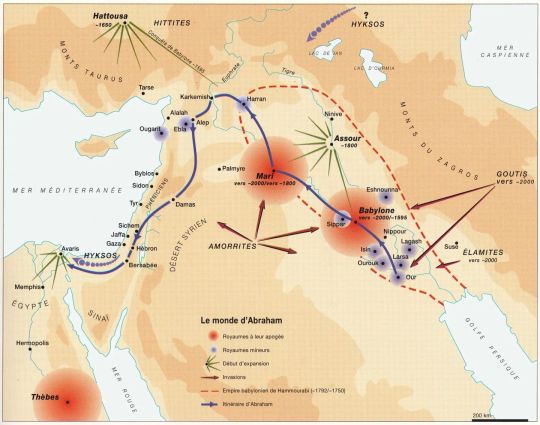
The world of Abraham, 18th century BC.
via cartesdhistoire
Source: « Histoire universelle des Juifs », Élie Barnavi, Hachette, 1992
Abraham, the father of monotheism, is with Isaac and Jacob one of the three patriarchs who founded the Jewish people. The biblical story of Genesis describes the wanderings of the Patriarchs across the Fertile Crescent, from the mouth of the Euphrates to the land of Canaan. The Bible places the Patriarchs in space but not in time, even if we can assume that Abraham lived in the 18th century. av. AD
Judaism constitutes the first expression of monotheism, but this appearance, far from being sudden, was the result of a slow evolution. Already in Mesopotamia, each state favored one deity among the many that populated its pantheon. In Egypt, the pharaoh Akhenaten (1353-1337 BC) had decided to worship only the god Aten and to do so had launched a vast iconoclastic campaign intended to eradicate all traces of worship of the god Amon. Here we see the outline of a shift towards henotheism, namely the idea that if there are several divinities, one of them is superior to the others.
From henotheism comes monolatry, namely the fact of worshiping only one god without denying that there are others. The development of henotheism stems from a form of nationalization of the gods which was notably encouraged by the Achaemenid Persians within their empire. In the biblical story of the Exodus, the alliance that the prophet Moses concluded with Yahweh was conditioned by the latter on the fact that the people of Israel made him their sole and exclusive god and renounced honoring others, which clearly shows that the existence of other gods is then recognized.
It was only around the 6th century. av. BC that Judaism asserts itself as a monotheism, that is to say that it postulates the existence of a single and universal god and therefore considers any other religious belief to be false. The true innovation introduced by monotheism is not so much the idea of divine unity as that of exclusivity and, with it, of truth.
96 notes
·
View notes
Text
Kemetic Influences on Fire Emblem Three Houses (Part 1)
I know I have made a more unstructured post regarding this before; however, I am certain in my assessments that the influence of Ancient Egyptian mythology had on 3H is vast and more varied then I, personally, have seen people discuss. Yes, we know of the etymology behind Sothis and Seiros' names, but I believe these connections go much deeper than the surface level.
This will be structured with me discussing what I am most sure in to what is more interpolation on my part. This part about Sothis is so long that it needs to be it's own post entirely.
Sothis is based on Hellenistic/Roman period worship of Lady Isis
As we know, Sothis' name can be traced to one of the names of Sirius, specifically the Hellenized name of Sopdet the goddess of said star. However, this is surface level. Sopdet was often syncretized with Isis during the Hellenistic period and in Lady Isis, I believe, there are more clear allusions to Sothis and how she acts as a deity within 3H's world.
Lady Isis is an Egyptian deity who was worshiped across the Mediterranean during the Hellenistic and Roman period. Sothis in her mythology, actions, and how she is depicted in-game shares remarkable similarities to Isis. The images and sources I will be using as a reference come from Dr. Andrew M. Henry's (ReligionForBreakfast) video on the topic and FEDatamine for everything regarding 3H.
Sothis and Isis are both "great mother" deities who act as supreme goddesses to their followers.
Even before coming to supreme status in the Mediterranean, Isis was an incredibly important goddess within Egypt. She was the bringer of magic, a guardian of women, a compassionate goddess who wished to relieve all human suffering, and much much more. All of these traits are extremely close if not direct parallels to Sothis.
We know that magic within Fodlan is directly connected to Sothis through the visual of all the magic circles (save for Agarthan dark magic) and it can be postulated that, like Isis, Sothis magic was beyond the capabilities of other humans or other deities.
Faith magic in particular is directly correlated with the ability to heal and protect, which is one of the main domains of Lady Isis in antiquity and modern day. She was the healer of the sick and injured, so much so that she often traveled in human form so that she could aid those who called out to her. I don't believe it is a coincidence that healing magic was reskinned as faith in this game given that context.
And the connections continue beyond that. Consider this text from a temple to Isis in Cyrene:

During the Hellenistic period, Isis' power and prominence grew to wear she became a supreme goddess within these polytheistic societies. She was believed to be the ruler of time and fate itself, and, as stated here, one of the creators of the cosmos who first set time to course. She was often depicted holding a steering rudder or with the planet beneath her very feet as the goddess through which all fate flows.
Next, take this quote from Lucius Apuleius: The Golden Ass a text from a satirist, but nonetheless believed to hold elements of truth to Isis' worship during the Roman period.

Once again, we see the language that would describe a supreme, cosmic deity. Compare to similar wording in The Book of Seiros Part 1:
"The goddess is all things. She is heaven above and the land below.
She is eternity incarnate. She is the present, the past, and the future.
Her eyes see all. Her ears hear all. Her hands receive all."
Due to this language, it is believed by some religious scholars, and presented within the video, that within the mysteries of Isis there was an element of henotheism at play. A philosophy within religious practices where one god is worshiped a supreme deity whilst not denying the existence of other gods, and such a system of worship is what I believe to be happening within Fodlan's religious context. Other gods are known to exist, they are spoken of in the Book of Seiros; however, Sothis is supreme goddess of Fodlan.
Now, I ask, what is Sothis' primary characteristics within the Church of Seiros and as depicted in game?
She is the supreme Goddess of Fodlan, who's depicted with having control over time and fate itself (literally divine pulse), spoken of as a savior not only in the past but also through the actions of her vessel Byleth, who created all life (or at least the Nabateans) as "The Beginning", and the arbiter of souls as an explicitly afterlife related deity.
All of these traits are direct parallels to Lady Isis, and I am not even finished listing all the similarities.
First take this quote from The Book of Seiros Part 2:
"In the beginning, amid the great cloudless ocean, Fódlan came to be. At the end of a long journey, the goddess glimpsed that land and there alighted. Upon that sacred ground, she breathed life into the world and created all of the creatures upon it.
By the goddess's hand, plants took root, birds took to the sky,
and animals roamed the land. Last of all, she created humanity."
Within multiple Egyptian creation myths one of the prevalent and constant features is the primordial ocean of Nun. It was place of nothingness and chaos all at once, a "cloudless ocean" if you will. And from that ocean came the first land, the benben, and from there any number of gods created all life. This includes Isis, who within the inscriptions at Philae, is described to have created all life and the cosmos itself (Žabkar 1988, pp. 134.):
"Indeed, she is the Lady of Heaven, Earth, and the Nether World, having brought them into existence through what her heart conceived and her hands created..."
Both of them are related to the afterlife and are explicitly called out as deities of fate. Once again from the story of Apuleius:
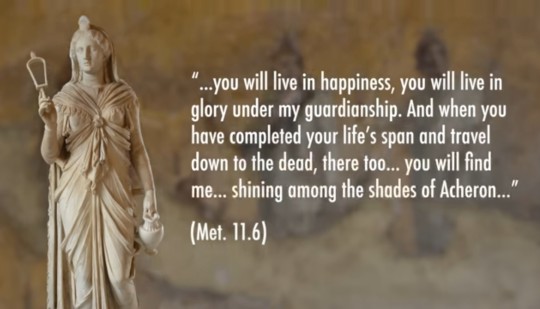
Lady Isis' connection to the afterlife as she who guides the soul to it's fate goes back even further in Egyptian texts and she has been a funerary deity all the way back in Old Kingdom Pyramid Texts. Take that in context with Rhea's line of Sothis being the "arbiter of souls" and much of her cosmology in-universe revolving around the afterlife you have another link between them.
Isis was said to be able to prolong a person's life if they were to follow her mysteries as she knew the lifespan of all people and could manipulate it with her magics. She also typically interacted with her followers via dreams. This is something Sothis is shown to do constantly with her appearing in Byleth's near death moments, within their dreams (at the beginning of the game and later during her speech regarding Fodlan's plight. And can I say, Sothis being aware of the blood being split and awakening Byleth to explicitly put it to an end is a very much like a savior goddess). Then, in Rhea's backstory, she said that she heard Sothis' voice within the Holy Tomb (or within Enbarr) and that is what lead her to take up the name of Seiros and begin to fight against Nemesis.
Sothis inspiring the creation of the Adrestian Empire through Seiros, and Byleth's place to chose the fate of Fodlan, directly correlates to Lady Isis' role as a goddess of kingship. Her protection was explicitly called upon both during the defense of Egypt and during campaigns of military conquest, and that she alone was comparable of armies of soldiers.
Isis and Sothis both are also transparently related to nature. They are callers of the rains (cited in the Philae Hymns for elsewhere and in-game for Sothis) and related to bounties of the harvest. In this way, Sothis may also cross into the sphere of Osiris who was more explicitly a fertility god and the ruler of the dead/judge of souls.
An interesting similarity can be called to the myth of Osiris' death and dismemberment at the betrayal of his brother Set, Isis' incomplete resurrection of her husband, and Horus' becoming king of Egypt after contending with his uncle where he avenged his father; with how Sothis herself was killed and dismembered for her power, then Seiros' creation of Adrestia (where he also chose the first king) to avenge her mother, and her inability to resurrect her due to Sothis' body being scattered and incomplete (at least, until her ib/Creststone was placed within the intact khet of Byleth). But that is an aside for now.
I want to finish this off with a look of the physical similarities between depictions of Isis and Sothis. Once again from Apuleius:
"Firstly her long thick hair in tapering ringlets was loosely spread over her divine neck and shoulders, and her head was crowned with a complex garland of interwoven flowers of every kind. At the centre, over her brow, a flat disc like a mirror or rather a moon-symbol shone with brilliant light.
Coiled vipers reared from the right and left of her coronet which was bristling with erect ears of corn. Her multi-coloured robe was of finest linen, gleaming here pure white, here a saffron yellow, there flaming rose-red, with a woven border flowing with flowers and fruit, and what dazzled me most of all was her jet-black cloak with its full sheen, wrapped gleaming about her, slung from the left shoulder, knotted at the breast, and sweeping over her right hip.
It hung in sweetly undulating complex folds down to a tasselled fringe, and along its borders and over its surface fell a scatter of glittering stars, round a full moon at the centre breathing fiery rays. And she bore a host of emblems."
To me, there are some similarities between this and the depiction of Sothis plus how Rhea dressed and Byleth's Immaculate One outfit. The floral motifs of lotus flowers, the crisp white of Sothis' mural appearance and those of Rhea and Byleth, the crowns of flowers and star motfis, the way Isis bears many emblems around her, much of it bears some similarities to Sothis.
But this is not the only depiction of Isis, let me show you some visual representations.
Let us compare this mural of Sothis to some depictions of Isis:

Here are two of Isis from Pompeii with one being a mural and another a famous reconstruction of a statue:


Again, while not 1:1 there are some visual similarities in design. The white linen of her dress and the cut of it are fair similar, as are the wings that are associated with nearly every depiction of Isis. To show and example from Egypt:

The fact that Sothis is shown with feathered wings in particular feels important given her other similarities with Lady Isis. Plus the throne hieroglyph that represents Isis and often often seen above her head looks exactly like the throne of Sothis as seen in the Holy Tomb. Lady Isis is also known as the "Lady of the Throne" just like how Sothis is called the "Girl on the Throne."
The amount of connections between them does not feel like coincidence to me. If you want to take the Romance into account as well, both Sothis and Isis are associated with floods in that case, especially with floods that are said to be caused by their sorrow. Sothis is a savoir deity who protected and saved from Fodlan from the destruction of the Agarthans; she is said to have caused a flood in the one, possible, Agarthan account we have.
Her name is Sothis, transcribed from Sopdet, lady of the blue star, who was syncretized with Isis who also became manifest within Sirius. I think I will make one more note: the Rite of the Goddess' Rebirth is transparently related to Wep Ronpet, the cosmological new year in Kemetic religious practice.
Both take palace in late July (or into early August for some dates of Wep Ronpet), both are related to the rising of a particular star (the Blue Sea Star is based on Sirius, this fact), both are related to the rebirth of the world and the gods, and both are a day of celebration with family and friends.
As one final aside: in Kemetic practice, worship of the gods has always been an intimate and close affair, both in antiquity and in modern practice. Gods are active and immediate presences within the world, and they are presently felt within physical parts of the world. Ra, Aten, and other solar deities are all the sun, Nut the sky, Shu the air and wind. Various "truths" about natural phenomenon could all be true at once and created a multi-facted view of existence. So Sothis having the Blue Sea Star as her "home" are acting as her spiritual double entirely makes sense within this framework.
Sothis' laws are also fairly similar to the Laws and philosophical underpinnings of Ma'at; however, delving into that is outside the scope of this post. So I will need to leave things off here.
#fe3h#fire emblem three houses#fire emblem#sothis fire emblem#fe3h meta#stars rambles#i'm sorry if this feel unorganized i've been trying to synthesize my thoughts for days#sothis having all these allusions to lady isis has been very obvious to me for years#so i'm happy to have post laying it all out#and obviously this isn't the only influence#but one that i feel doesn't get talked about enough#and it's important to me#so with that#dua lady isis
27 notes
·
View notes
Note
that post abt the wilderness and the (m)Othering god made me think of one of the few ratzinger w's somewhere in spirit of the liturgy where he talks abt how it's no wonder that monotheism first develops in desert wilderness where humans are so starkly aware of their aloneness underneath the infinite kind cruel sky
ratzinger was so close at meaningfulness here. but he is wrong at an important part: the hebrew bible is scarcely monotheistic. it's something more like henotheism, the worship of one god among many. asherah, baal, el, on and on: the bible leaves ample space for other gods, who both exist and have capacities paralleling hashem's. these other gods are available, seductive, imbuing prophets with a excess, with idle banality, with phallic efficacy (look at the plagues of egypt: the court magicians are able to reproduce god's work there; look at the sorceress of endor, who does what god refused to, etc. etc.)
what the israelites do in the wilderness, then, is not a denunciation of all but one; it's a turning-towards that one. the familial, maternal, womby-one. in that desert, under that cruel sky, hardly alone in the cosmos, and yet so alone the moment they undertake this turning-towards the singular mom-god, they make the risky, erotic choice to be singularly m/Othered
24 notes
·
View notes
Note
hey what's that banner from btw i love it
Thanks! It's from Kill 6 Billion Demons, my favorite webcomic. It has BY FAR the most interesting fictional religion I've encountered so far. A lot of fantasy stories have a some slight variation of classical theism, or henotheism. You usually get the sense that the author unwittingly copy-pasted Christianity and thought they were being creative.
K6BD is actually creative. The religion Atru draws inspiration from Advaita Vedanta, Gnosticism, Daoism, and Philipp Mainlander (or, if not inspiration, at the very least it simultaneously parallels these wildly different religions/philosophies). I'm going to do a YouTube video or long-form essay about this eventually lmao.
I reblog pics all the time under the tag k6bd. This is from the first few pages of Volume 2: Wielder of Names.
Here's some of my favorite visuals from the comic:



52 notes
·
View notes
Text
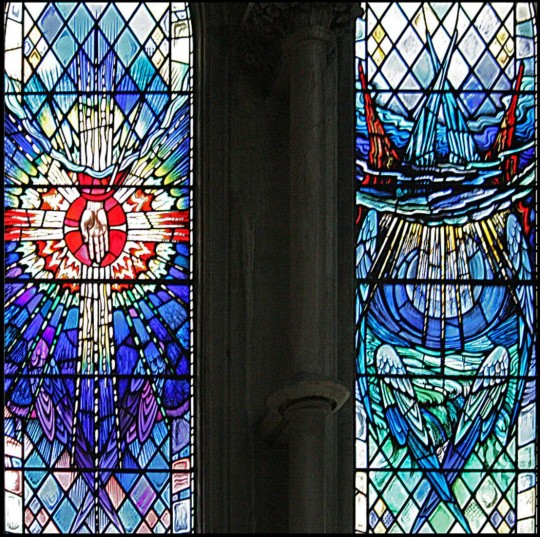

MONOTHEISM is simply defined as the belief in one god and is usually positioned as the polar opposite of polytheism, the belief in many gods. However, the word monotheism is a relatively modern one that was coined in the mid-17th century CE by the British philosopher Henry More (1614-1687 CE). It comes from the Greek words, monos (single) and theos (god).
In the Western tradition, this 'belief in one god' specifically refers to the God of the Bible; the God of Judaism, Christianity, and Islam (and always written with a capital G). However, in the ancient world, the concept of monotheism as we understand it today did not exist; all ancient people were polytheists. They may have elevated one god as higher than the others (henotheism) but nevertheless recognized the existence of divine multiplicity.
The concept of the universe for the ancients consisted of three realms: the sky (the heavens); earth (humans); and the underworld (sometimes known as the netherworld or simply 'the land of the dead'). The sky was the domain of the gods and was crowded with a host of divinities understood in a gradient of powers. Many ancient civilizations had a dominant god, or a king of the gods, with other divinities being in charge of various aspects of life, serving as a court of advisers, or simply as messengers to humans below.
Read More Here
121 notes
·
View notes
Note
Do you ever wonder about the significance of gendry being a rhollor follower and Arya following the old gods? Or that gendry is apparently a nickname for a person who inherits estates from his father-in-law? Love your gendrya art!! Thank you for drawing nook gendry with his mop of black hair
I love the fact that Gendry has changed his religion, it's a detail that denotes a lot of attention from Martin even to things that could get lost in the background. It's obvious to expect that after so many unfulfilled prayers to the Seven gods, a priest of R'hllor resurrecting someone in front of your eyes would convince anyone. it's a very sensible choice because I imagine that Gendry, given his social background, grew up with a rather practical vision of religion. I mean that Gendry, in my opinion, doesn't think that r'hllor is necessarily the best god to worship from a moral point of view, but he is the only one who has given unequivocal proof of his existence.
Then Arya's faith is much more complicated. It seems to me that at this point of her story she believes in both her father's gods and the Many-Faced God and decides to turn her prayers one way or the other depending on what she seeks . In a certain sense it's a vision almost halfway between polytheism and henotheism. This elastic attitude about worship makes a lot of sense considering Arya was raised with two different religions, and believing both of them to be true.
What's interesting in regards to the future is the R'hllor/Old Gods conflict that Stannis' army has brought to the North. I'm not particularly fond of the "Gendry next lord of Storm's End" theory, but perhaps it will be his conversion that will help him gain acceptance among Stannis's men (aside from the fact that he's clearly got Baratheon blood).
The fact that Arya believes in the Old Gods and Gendry in the Red god kind of picks up on the recurring theme of ice and fire.
Both of these religions will play a role within the resolution of the War for the Dawn because they are the only ones that have proven themselves to be true with their magical effect on the world.
108 notes
·
View notes
Text
Mycogenous – a book exploring Dionysos in the fungal realm
This isn't my book. This is Dver's book. And it is something she has been working on for some time as part of her devotion to Dionysos.
"Dionysos has always come first for me – I discovered Him before I was even properly pagan, and He was the first god I came to when I started studying polytheist traditions, and has remained by far the most important god to me, sometimes almost to the point of henotheism. I think of myself as a Dionysian as much as anything; He is at the core of who I am. And yet, all these years, everything I’ve written, and only now have I finally created a book entirely dedicated to Him. Only now do I feel I have something to say, to share, to offer those looking to connect with Him. Something very special to me."
This is a different Dionysos than most people encounter. This is not the Dionysos of the revelry, of the enthused intoxication, of the excess of movement and sound and action.
"For this Dionysos is not the familiar god of the wild animal, or the verdant vine, but rather a fungal god – not just symbolically but literally. He is the Dionysos that brings life out of death, that dissolves boundaries, that opens doors, that effects transformation…all through the varied manifestations of the fungal kingdom. And no, I am not just referring to mushrooms (mind-altering or otherwise), although they are part of it. I’m also talking about the kind of fungus that rots the dead, the kind that intertwines with trees, the kind that turns grapes into wine, the kind that heals, the kind that destroys, the kind that spreads and changes everything it touches.
I have taken to calling Him by the title Mycogenous Dionysos."
This is not a history book. Not an art book. Not a text book of spells and rituals. This is a devotional.
"In this book, I use a combination of prose, poetic allusion, and visual art to convey something of what I have experienced and learned, in hopes of helping the mycelium of Mycogenous Dionysos to spread. I don’t know who, if anyone, will feel called to this path, or resonate with it, or be taken wholly by it as I have, but I know I need to put it out there. I need to release the spores; it is not up to me where they land."
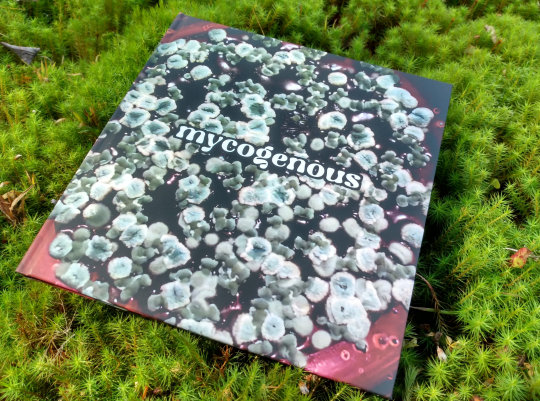
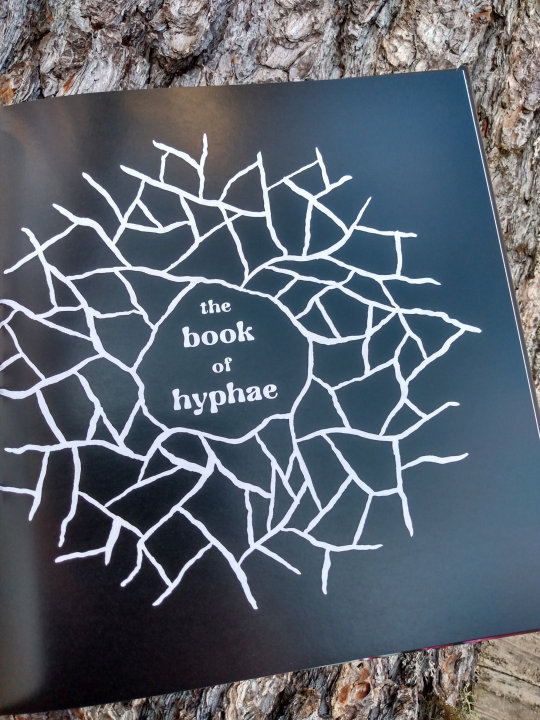
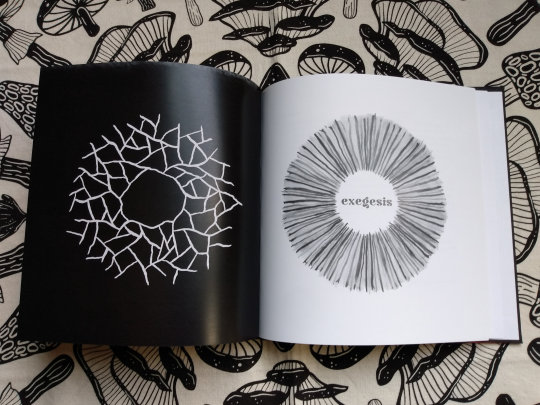

Mycogenous
7.5×7.5 inches, 82 pages, 80# semi-gloss paper, matte casewrap hardcover
"Incorporates reproductions of several original ink and brush illustrations created for this project, as well as three tipped-in color plates of masks I made several years ago as I began delving further into this path."
Available only in Dver's Etsy shop
As always, I would appreciate any help spreading the word about this, as I do not have social media or any other way to communicate beyond this blog and my shop. While I wrote this for polytheists and especially for Dionysians, I do wonder how it might resonate with those unfamiliar with the god but drawn to fungi or spiritually connected to nature, so please feel free to disseminate beyond the pagan world.
If you would like to encounter more about Dver, her devotional practices and offerings, and her other works, her blog can be found at https://forestdoor.wordpress.com/
#Dver#Dionysos#fungus#mold#devotion#pagan#book#Mycogenous#If you know someone this would interest please share this post.#Dver does not do the socials.
17 notes
·
View notes
Text
@margridarnauds // can I just say I love all of your tags on my post? And yes I agree so much. Especially part part, it's why I don't play clerics often for bg3 (unless I'm doing wacky multi-classing, xD). There is one exception to this.
Icewind Dale is an good game to play play a cleric of Tempus in due to his faith being important to the location by both friendly and hostiles. In terms of this sort of thing being handled well.
Viconia's relationship to Shar and Lolth are very well explored in BG1&2. What drew her to Shar, and what broke her faith in Lolth.
See D&D setting is a "Henotheism" many gods are accepted d to be real, but one deity is worshiped above others. Except in D&D's case that one deity is by choice of the individual. BUT I don't think D&D knows this, and everyone just this is this polytheism, lmao. If you ever want to explore that further for bg3 or D&D stuff.
5 notes
·
View notes